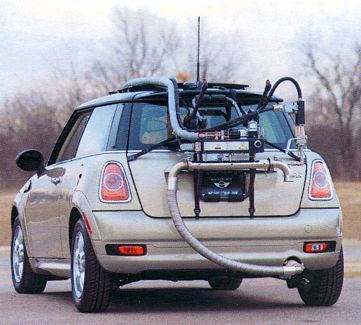Feature: Sensors expanding PEMS emission analyzer lineup
16 September 2011
With the introduction of two new product lines this year—the Semtech Ecostar and Lasar analyzers—Sensors Inc. intend to strengthen their position as a leading developer and manufacturer of portable emissions measurement systems (PEMS). The new analyzers can also be used in a test bench, which reflects the company’s business strategy of developing versatile, high end emission testing systems that can be used both onboard of a vehicle and in the emission testing lab.
Founded in 1969, Sensors became a major supplier of optical benches for I&M (Inspection and Maintenance) testing programs. Infrared (IR) cells from Sensors have been at heart of many major brands I&M emission analyzers sold in North America, Europe and Asia. As the growth prospects in the I&M analyzers market are limited—with advanced onboard diagnostic (OBD) systems increasingly used to obtain the required information, including in-use emissions—the company specialized in high end portable emission analyzers for on-vehicle applications. The development of the Semtech mobile emission analyzers coincided with the launch of the in-use emission testing program for heavy-duty engines and vehicles by the US EPA. The instruments were widely used by the agency and by the engine manufacturers taking part in the program, which helped establish the company’s position as a major PEMS supplier. In 1999, Sensors Inc. acquired Sensors Devices in Germany, ensuring a presence in Europe and expanding its product base to include analyzers for environmental applications.
This year, Sensors expanded their product range with the introduction of two new emission analyzers:
- Semtech Ecostar—A new generation, modular, EPA part 1065 compliant mobile test bench, and
- Semtech Lasar—A laser absorption spectrometer capable of measuring a number of gases, such as N2O, NH3, and CO2, from ppb levels to high concentrations.
The Semtech Ecostar is the fourth generation PEMS system from Sensors. Unlike previous generations where all functional components were built into one enclosure, the Ecostar system uses a modular design. The following modules are available:
- FEM—Fuel economy meter: Measures CO and CO2 (IR), and optionally O2 (paramagnetic). Calculates fuel economy.
- NOx—Non-dispersive ultraviolet NO and NO2 analyzer.
- FID—Flame ionization detector THC analyzer.
- MPS—Micro-proportional sample system: Dilutes exhaust gas sample.
- PMF—Particulate mass filter system: Collects PM sample for analysis.
- PDM—Power distribution module.
The sample is collected from the tailpipe via a flow tube/heated filter unit which measures the exhaust flow rate and provides sample conditioning. From the flow tube, the sample is fed to the analyzers through dual sample lines: a heated line for the FID and an unheated line for the other analyzers.


Each Ecostar module works as a stand-alone device, with the ability to be integrated with other modules. The system features rugged, weatherproof construction. Options include GPS, vehicle protocol interface, and a weather probe for ambient humidity and temperature. The system complies with US EPA part 1065 requirements for in-use and test cell applications.
The Semtech Lasar utilizes the technique of optical feedback, cavity enhanced absorption spectroscopy—a direct intensity measurement relying on active frequency mode locking between the laser and a resonant cavity. The non-fibered scanning laser provides information at 200 different wavelengths every 100 ms, for multi-gas analysis and self referencing capabilities. The spectroscopy design provides an extremely long, up to 20 km, pathlength in the resonant cavity. This techniques can provide linear response over four orders of magnitude of concentrations, making it possible to analyze concentrations from ppb levels to 100%.
This measurement technology—developed by AP2E in France—has been introduced in Europe for the monitoring of ambient greenhouse gas concentrations. The Semtech Lasar is the first application of this technique for automotive emission measurement, intended as a new tool for engine developers and researchers who need to quantify emissions of greenhouse gases (including methane and nitrous oxide), as well as several unregulated emissions from internal combustion engines.
The instrument can measure a wide range of gases, including NH3, NO, N2O, NO2, H2S, HCN, SO2, SO3, H2, O2, as well as several aldehyde, alcohol and hydrocarbon species with one (CH4) or two carbon atoms. These capabilities make it a new alternative to FTIR analyzers widely used in the automotive industry to analyze many of the above species. Compared with FTIR, the Lasar can offer a number of advantages, such as no moving parts, hygroscopic optics or liquid nitrogen cooling requirements.
The instrument has several noteworthy features, including:
- No sample conditioning: The spectrometer uses low pressure sampling, where a vacuum pump draws the sample through a critical orifice (positioned at the sampling point), lowering the pressure inside the entire gas flow sampling assembly to 50-100 mbar. As the reduced pressure lowers dew point temperatures, there is no risk of condensation. In most applications, there is no need for heated sampling lines.
- No interference: The low pressure (50 mbar) operation, coupled with 1 picometer optical resolution, improves the resolution of absorption bands for the gas species and helps to control interference.
- Auto-zero and no drift: The absorbance spectrum includes bands characteristic for a given species, as well as regions of zero absorbance. These zero absorbance regions are used to automatically re-zero the spectrometer every 100 ms. Since the zero information is derived from the spectrum itself, the instrument does not require regular re-zero.
Sensors have been hosting the Semtech User’s Network (SUN) Conference—an annual meeting that covers emission measurement technologies and worldwide emission regulations. This year’s conference, to be held next week (September 20-21) in Ann Arbor, MI, will include technical presentations on both the Ecostar and the Lasar analyzers.